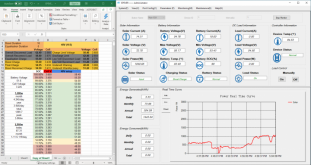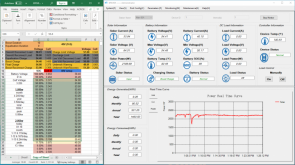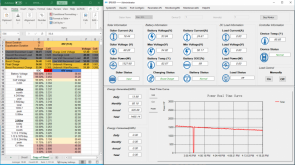Hi Fafrd. I would recommend the EPEver controllers. We have finally learned how to live with one another. I just replaced my cheap MakeSkyBlue third controller with a 5420AN 200V model. I don't have the third array up yet, but the Blue produced so much interference my monitoring circuits kept getting errors.
The lithium screen is in the setup software. I found it from this forum but had mine setup just fine without it. EPEver has added some niceties for lithium that I don't need. It has low and high temp protection. I don't need them. You might. I moved my battery bank into a temperature controlled space when I switched from AGM to LiFePO4. You can configure everything you need via the MT50 or plug in a PC to see everything at once. It has a clock that keeps drifting. Not sure how it uses it. It has no battery back up and seems to lose time. It reminds me of the real time clocks in PCs back in the 90s. The harder the CPU worked, the less accurate the clock was.

In any case, having to reboot the controller by disconnecting from the batteries seems to cause it to lose its date and time completely.
I’m not terribly worried about temperature protection or clock accuracy, but I do want to understand why Epever has stated that their ‘high current’ AN-Series chargers will not ‘work with’ lithium batteries. Will contact them about that and will report back what they say.
jnrhome and I both run continuous loads and therefore we need to look at the charge setting much differently than someone who is say using it in an RV while camping. I need my batteries to last the night and on cloudy days therefore I want my batteries to be as full as possible when the solar kicks out.
Mine is for residential as well (not RV).
I want to start charging when the sun comes up in the morning and to begin powering an inverter once the battery reaches a minimum SOC (~30%) at which point I will generally have enough solar coming in to power the inverter while continuing to charge the battery.
As the sun sets, inverter will slightly outweigh solar power coming in, but I should enter the evening with a pretty full battery at which time I will drain it powering loads in the evening and overnight.
So 75% of what I am doing is time-shifting while the remaining 25% is dynamically powering loads during the day (primarily fridges and freezer).
Therefore boost/bulk is the fullest they should get most of the time. See my post about resetting the controller during the day. The float is the setting you want the batteries to be at when the sun goes down. Note please that if you don't have a continuous load, use the conventional wisdom not what I'm telling you.
Appreciate the advice but I’m still in the charger-selection phase.
Playing with the settings over the last view days has made a tremendous difference in the performance of my system. Cloudy days aside I've gone from ending my charge day at 26v to ending it at 26.7v. That's about 35% capacity vs 90% capacity. On the 35% day the transfer switch flipped at 24v to building power, my software kicked the inverter off at about 1am (24w load), the controllers followed but by sunrise I was still down near 21v. I've since fixed the timing of things to prevent that from happening again but you get the point. You can tune the parameters to make the most sense for your needs.
My main two concerns are:
1/ avoiding a charge overshoot (perhaps that was just not using the correct settings)
2/ avoiding wasting available solar energy when the battery becomes fully-charted but then more loads start using some pf that power.
But of course, this is all after confirming with Epever that the 60A 200V charger has no limitation preventing it from working with LiFePO4 batteries...
In case it helps, I have an 8S LiFePO4 200ah battery bank. I have two arrays of 1200w each. The first is 100w panels. The second is 200w panels. I have a third but its not setup. I'm working on the ground mount now. It will be 1320w of 330w panels. I have two EPEver 5415AN controllers running the first two arrays. I have an AIMS 2000w low frequency inverter. If you want to start motors and compressors (a dehumidifier in my case), look for low frequency inverters. At odd times I've run a 12 inch cutoff saw and a tank compressor...not at the same time of course.
Good luck with your project.
This is helpful. I’ve also got a 24V LiFePO4 (2P8S). Biggest difference between my setup and yours will be that I use GTIL inverters to partially-compensate for loads during daylight hours and while the batteries last (no transfer switches needed and no concerns about startup surge).
I’m putting in 10 450W panels but will treat them as 4 separate arrays due to shading issues.
So I’ll have 3 60A 24V MPPTs and a lone 20A MPPT and I’m happy to hear you’ve had no issues running multiple Epever MPPTs in parallel.









